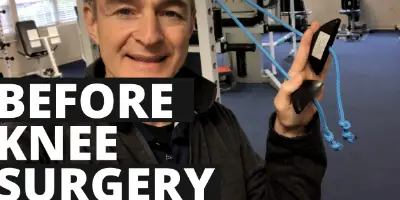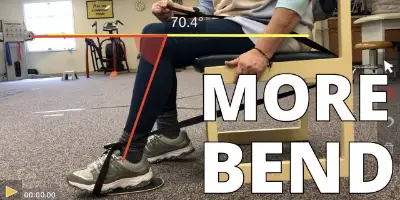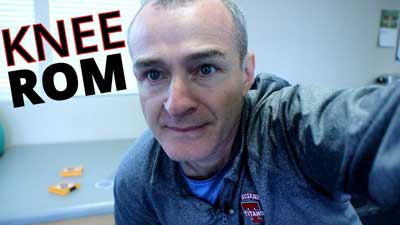Sleeping After Knee Replacement – 3 Best Positions
Finding a comfortable sleeping position after a knee replacement can be challenging. The most common advice is to sleep flat on your back with your surgical knee straight and elevated above your heart.
To achieve this, many surgeons recommend propping a pillow under your heel or using a straight wedge pillow under the surgical leg. But what about those of you who can’t sleep on your back due to other medical conditions?
What should you do?
1. Sleeping on your back
Why is sleeping on your back the most common recommendation?
Pros:
🟢 Sleeping on your back allows you to position your surgical knee in full extension.
🟢 It also enables you to elevate the surgical leg above the level of your heart to reduce swelling.
Cons:
🔴 Many individuals who have undergone a total knee replacement also suffer from low back pain associated with spinal stenosis and are unable to sleep flat on their back.
🔴 Neck pain is a common complaint for those who aren’t used to sleeping flat on their back.
Recommendations:
If your knee range of motion is improving along expected guidelines and you’re not experiencing significant swelling, consider sleeping in any position that is most comfortable for you.
2. Is it safe to sleep on my side after knee replacement?
Yes, side sleeping positions are safe and sometimes recommended after knee replacement surgery. If your knee range of motion is within the expected normal degrees based on the time since surgery, then you are encouraged to sleep in any position that provides you the best restorative sleep.
Two side sleeping positions:
- With your surgical knee down on the mattress. In this position, the bed contours to your leg. Try to keep your knee straight while sleeping on this side.
- With your surgical knee on top. In this position, you may use pillows to support the surgical leg and keep your knee above the level of your hip. This position makes it harder to keep the knee fully extended, but if your knee range of motion is within normal limits, your goal is simply to sleep well.
3. Is it safe to sleep on my stomach after knee replacement?
Yes, sleeping on your stomach, also known as prone, is both safe and an effective way to improve knee extension. The primary difference between sleeping on your stomach versus sleeping on your back with your leg propped is that the prone position will not reduce swelling. If you’ve always slept on your stomach or partially turned toward your stomach, you should be fine to return to that sleeping position.
Some patients may be concerned about the incision. If you experience significant sensitivity over the incision, there are strategies to reduce this sensitivity, but any danger in allowing the knee to rest incision down on the mattress.
Where do you put a pillow after knee surgery?
When sleeping in the supine (on your back) position, place one to three pillows under your surgical leg while attempting to keep your knee straight.
In the video below, you can see how to arrange pillows under the surgical leg to reduce swelling and position the knee comfortably:
You may also choose to use a wedge pillow if it is easier. You can find a great selection of wedge pillows on Amazon by clicking this link.
Frequently Asked Questions
-
How long should I keep my leg elevated after knee replacement surgery?
It is generally recommended to elevate your surgical leg above the level of your heart for the first few days after surgery, especially when you’re resting or sleeping. Gradually decrease the elevation as your swelling and pain decrease. It’s important to follow your surgeon’s and physical therapist’s recommendations for your specific case.
-
When can I start sleeping without a pillow under my surgical leg?
As your knee range of motion improves and the swelling decreases, you may start to feel more comfortable sleeping without a pillow under your leg. It’s essential to listen to your body and follow the guidance of your surgeon and physical therapist, who can provide personalized advice based on your recovery progress.
-
Can I use a recliner for sleeping after knee replacement surgery?
Using a recliner for sleeping after knee replacement surgery can be a good option for some individuals, as it allows for easy elevation and support of the surgical leg. However, it’s important to ensure that your knee is still in a comfortable, extended position while using a recliner. Consult with your surgeon or physical therapist for recommendations tailored to your specific situation.
About the Author -
Anthony Maritato, PT has been a licensed physical therapist since 2006. He specializes in post surgical care and rehabilitation of total knee replacement and rotator cuff repair surgery.
Mr. Maritato is also nationally recognized as a therapist educator teaching courses related to Medicare reimbursement, contracting, and documentation.
Total Therapy Solutions LLC is Tony's primary practice which he owns with his wife Kathy who is also a licensed physical therapist.
More Blog Posts …

Low cost minimalist shoes
Finding a low cost yet durable minimalist shoe can be challenging. Here is one that I have tested.

Best Minimalist Shoe In 2018 On Amazon – By A Physical Therapist
Minimalist shoes allow your foot to act like a foot. The ability for your toes to move, your arch to flex, and your whole lower kinetic chain to function is one of the main reasons to consider transitioning to a minimalist shoe.

Best Position To Sleep After A Total Knee Replacement
The best position to sleep in after a total knee replacement is flat on your back with a pillow under your heel.
This is because this position allows the knee to remain in full extension throughout the night.
If you are not experiencing difficulty achieving full knee extension you may prefer to sleep in other positions.

How To Use A Stationary Bike After A Total Knee Replacement
The upright stationary bike is a very common tool used in the rehabilitation of your total knee replacement. In many cases the upright stationary bike is preferred because it reduces the knee flexion requirements. In this video I show you some tips for using a stationary bike at home and turning a standard upright bike into a recumbent bike.

How to prepare for knee replacement surgery?
There is a lot you can do before your total knee replacement surgery to prepare. Step 1: Improve your cardiovascular fitness – your body will be dedicating much of its time and energy to repairing tissue. The better your heart and lungs are working the better your body can recovery. Step 2: Strengthen the rest of your body. While you are waiting on your knee surgery, you can strengthen the other 87% of your body. Step 3: Get your game face on. There will be plenty of mental and emotional challenges along the path to recovery. The better you prepare yourself to face these challenges the better you will be to overcome them.

Easiest Way To Increase Knee Bend At Home After A Total Knee Replacement Sitting – Real Patient
There are an infinite number of ways to bend your knee and all too often I see clients who have been told heel slides need to be completed while laying on your back. That simply isn’t the case. In this video I show you how to perform heel slides seated in a chair and using a strap to assist.

3 EASY Ways to Measure Knee Flexion at Home
Learn 3 easy ways to measure knee flexion at home.
